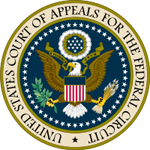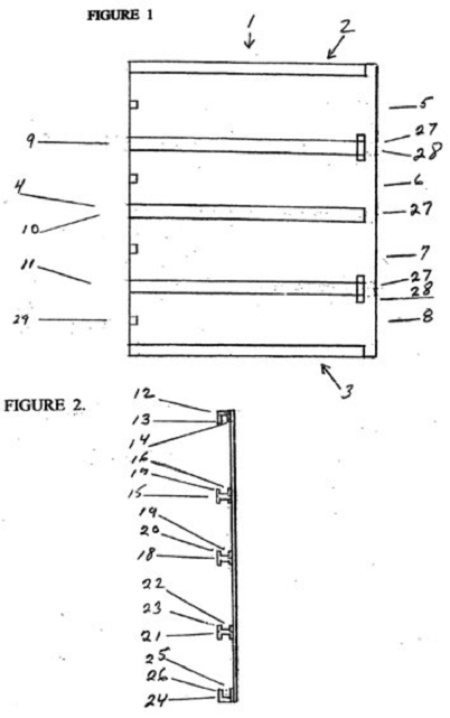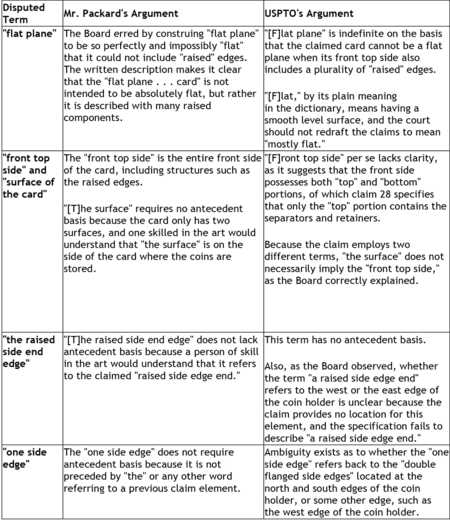 Often times it appears that, serendipitously or by design, the Federal Circuit issues an opinion on an aspect of patent law that the Supreme Court is also considering. And sometimes the shadow of the Court's impending decision, like an unobserved new planet or dark star bends the appellate court's decisions in ways consistent with the likely view of the law expected to issue from the Court (because the Supreme Court rarely grants certiorari in an appeal from a Federal Circuit decision just to affirm). In its decision in the Packard case, the Federal Circuit takes a different tack, relying on the differences in how a claim's compliance with the patent statute's indefiniteness standard is assessed during prosecution compared with the "insolubly ambiguous" standard now under Supreme Court review in Nautilus v. Biosig. Incredibly, the panel asserts that the Court has never addressed this question of the proper pre-issuance indefiniteness standard that the Patent Office should apply.
Often times it appears that, serendipitously or by design, the Federal Circuit issues an opinion on an aspect of patent law that the Supreme Court is also considering. And sometimes the shadow of the Court's impending decision, like an unobserved new planet or dark star bends the appellate court's decisions in ways consistent with the likely view of the law expected to issue from the Court (because the Supreme Court rarely grants certiorari in an appeal from a Federal Circuit decision just to affirm). In its decision in the Packard case, the Federal Circuit takes a different tack, relying on the differences in how a claim's compliance with the patent statute's indefiniteness standard is assessed during prosecution compared with the "insolubly ambiguous" standard now under Supreme Court review in Nautilus v. Biosig. Incredibly, the panel asserts that the Court has never addressed this question of the proper pre-issuance indefiniteness standard that the Patent Office should apply.
The case arose as an appeal from the Patent Trial and Appeal Board's affirmance of the Examiner's final rejection for indefiniteness of the claims of Mr. Packard's patent application directed towards a coin change holder illustrated by Figures 1 and 2 from the application:

Claims 28, 29 and 34 were declared to be representative in the opinion:
28. I claim a small, thin, flat plane, rectangular change holding card and wallet/billfold or purse construction with the front top side of the card comprising three raised, straight, parallel, double flanged separators and two raised, straight, parallel, double flanged side edges and a raised side edge end thereby forming four parallel, side by side, flanged coin holding channels or rows of the same length and of different widths, one for quarters, one for dimes, one for nickels, and one for pennies, that are similarly blocked at one side edge by the raised side end edge with the other side of the channel/rows open except for small, fixed, flexible, partially moveable, rubber or plastic retainers that are attached to the topside and ends of the double flanged separators such that coins can be retained on the card and yet slide freely above the surface of the card and obliquely overlap as necessary within the channel/rows between the separators while the bottom, back side of the card is constructed with a wallet, billfold or purse extending from it.
29. The change holding card wallet, billfold, purse of claim 28, wherein the change holding card is constructed as part of the wallet, billfold, or purse and affixed to a surface and contained within the wallet, billfold or purse.
34. I claim a small thin uniformly flat plane rectangular coin holding card [c]omprising side edge retainers, a closed side retainer, small inclined/sloped end protrusions, multiple raised parallel, straight and double flanged channel/row separators, small flexible protruding retainers on the top side ends of the channel/row separators, all of which are arranged on the upper surface of the card such that a various denomination of coins can be held and retained on the card within a respective channel/row and can slide freely within the double flanges and slightly above the flat surface of the card and can also be stored obliquely partially overlapping.
The Examiner's rejections were based on the following terms, and the corresponding contrary rationales between the Applicant and the Office:

During prosecution the applicant refused to further disclose the meaning of these terms or their bases, and as a result the Examiner maintained her rejection that these terms were indefinite for being (merely) "unclear," pursuant to the Manual of Patent Examining Procedure (MPEP) § 2173.05(e). Before the Federal Circuit, as he had before the Board, the applicant maintained that the proper basis for rejecting claims under 35 U.S.C. § 112(b) was to apply the Federal Circuit's "insolubly ambiguous" standard, and further argued that under this standard if any meaning can be ascribed to the term(s) then the Office could not maintain an indefiniteness rejection.
The Federal Circuit disagreed, affirming the Patent Office's grounds of rejection in a per curiam opinion by a panel including Judges Plager, O'Malley, and Taranto. The panel cited the statutory provisions relating to what it termed "the USPTO's examination function (35 U.S.C. § 131) in applying the substantive law under § 112(b). As stated in Keystone Bridge Co. v. Phoenix Iron Co., 95 U.S. 274, 278 (1877), an applicant's "claim is, or is supposed to be, examined, scrutinized, limited, and made to conform to what he is entitled to" by the Office. Under prevailing Patent Office procedure, the process is iterative between the Office and an applicant, wherein the Office identifies deficiencies and failures to satisfy the statutory requirements of patentability in claims it examines and the applicant has the opportunity to amend, argue, or both in response. The panel noted that the Court has expressly approved this "procedural mechanism" in In re Piasecki, 745 F.2d 1468 (Fed. Cir. 1984), placing the initial burden of rejection (establishing a prima facie case) on the Office (through its examiners). That procedural approach is appropriate here, according to the Court.
In reviewing the question of indefiniteness, the panel noted that the basis for indefiniteness rejections during prosecution differ from the grounds that can be asserted after a patent has granted, citing Exxon Research & Eng'g v. United States, 265 F.3d 1370, 1380 (Fed. Cir. 2001). As a policy matter this makes sense, in the panel's view, due to the differences between the two circumstances (inter alia, the presumption of validity and the clear and convincing evidence standard for invalidating a granted claim, and without any consideration for the litigation standard -- the Court referencing that standard being under review in Nautilus, Inc. v. Biosig Instruments, Inc., 715 F.3d 891 (Fed. Cir. 2013), cert. granted, 82U.S.L.W. 3195 (U.S. Jan. 10, 2014) (No. 13-369)). This policy also protects the public interest, requiring a patentee to "notify the public of what is within the protections of the patent, and what is not," citing Merrill v. Yeomans, 94 U.S. 568, 573-74 (1876); and United Carbon Co. v. Binney & Smith Co., 317 U.S. 228, 236 (1942). But the panel noted the requirement does not compel claim language that operates with "mathematical precision" but rather is tailored to the claimed subject matter, citing Georgia-Pacific Corp. v. U.S. Plywood Corp., 258 F.2d 124, 136 (2d Cir. 1958) for this principle.
The panel also places the responsibility for claims lacking the statutorily required clarity on the applicant, stating that "[g]iven the role of the applicant in the process, it is a reasonable implementation of the examination responsibility, as applied to § 112(b), for the USPTO, upon providing the applicant a well-grounded identification of clarity problems, to demand persuasive responses on pain of rejection." "That approach decides this case," according to the panel, "because Mr. Packard did not offer a satisfactory response to well-grounded indefiniteness rejections in this case." And:
In some cases it is difficult enough for courts to construe claims when the draftsperson has made every effort to be clear and concise, let alone when the claims have readily observable ambiguities or incoherencies within them. Because Mr. Packard had an opportunity to bring clarity to his claim language, we affirm the Board's findings as to indefiniteness under the MPEP standard properly applied by the USPTO, the standard which we have here approved.
Judge Plager wrote separately because his view is that "a petitioner to this court seeking reversal of a decision is entitled to an explanation of why the arguments on which he relied for his appeal did not prevail" (and he believed that the per curiam opinion did not directly address the "significant" issues Mr. Packard raised). These involve the proper standards for indefiniteness, which Judge Plager writes the Supreme Court has considered "[a]s far back as 1853 in Brooks v. Fiske, 56 U.S. 212 (1853)" and concluded that "the overriding policy considerations [are] that claims must unambiguously define any invention over the prior art, and provide notice to the public." These considerations have been consistently applied by the Court, Judge Plager citing White v. Dunbar, 119 U.S. 47, 52 (1886), Merrill v. Yeomans, 94 U.S. 568, 570-74 (1887), Gen. Elec. Co. v. Wabash Appliance Corp., 304 U.S. 364, 372 (1938), and United Carbon Co. v. Binney & Smith Co., 317 U.S. 228, 236 (1942), in support of this proposition (as well as explicating all prior versions of the Patent Act back to 1836 as having the same requirements) ("throughout this history of patents, the statutory language regarding claim clarity remained largely unchanged, and indeed so did the understanding of what the statute requires").
Judge Plager also gets to the heart of Mr. Packard's argument, that the "insolubly ambiguous" standard for indefiniteness enunciated by the Federal Circuit in Exxon Research and Engineering Company v. United States, 265 F.3d 1371 (Fed. Cir. 2001), is the standard that must be applied by the Office during prosecution. That phrase, according to Judge Plager, was new, and the rest of the Federal Circuit's opinion hewed to the "traditional test for claim construction: whether the claims were so ambiguous that one of skill in the art could not reasonably understand their scope." Even this standard has not survived intact, according to Judge Plager, who cites the language from Datamize, LLC v. Plumtree Software, Inc., 417 F.3d. 1342,1347 (Fed. Cir. 2005), that "[s]ome objective standard must be provided in order to allow the public to determine the scope of the claimed invention." And to the extent that the "insolubly ambiguous" standard as "taken on a life of its own" it has also "generated considerable controversy (citing law review articles and blog posts).
But Judge Plager did not perceive it to be necessary to decide "whether the traditional test employed by courts for determining indefiniteness has or has not been modified or superseded by Exxon's 'insolubly ambiguous' phrase." Rather, he set forth the two types of difficulties in claim interpretation relevant to the definiteness question: whether a claim term is "incoherent" or whether it is ambiguous. The former results in a term that cannot be construed, because "there is no reasonably understandable meaning of the term in the context in which it appears." For such terms the skilled worker "cannot ascertain any reasonable meaning of the term as used" (emphasis in opinion). An ambiguous term, on the other hand, is just one that is subject to multiple reasonable meanings. This leads to the situation where there can be one of three choices in construing the term:
1) Give controlling weight to the policy of upholding the USPTO's decision to issue a presumptively valid patent, with substantially less concern for the notice function of patents.
2) Give weight to the notice function of patents, while still recognizing the role of the presumption of validity.
3) Give full weight to the importance of the notice function of patents, recognizing that it is the claim drafter/patentee who is ultimately responsible for problems created by ambiguous terms.
Judge Plager identifies the first of these options as being most consistent with the "insolubly ambiguous" standard. These considerations are used by courts post-issuance, according to Judge Plager; in contrast, the PTO's standard, as Judge Plager states it, is that ambiguity in claiming, whether intended or inadvertent, is not acceptable (a standard that comports most closely to the third option above). This standard "goes well beyond what this court is known to apply to claim interpretation when the issue is post-issuance compliance with § 112(b)" according to Judge Plager. But "it is within the authority of the USPTO to so interpret the applicable standard," in Judge Plager's view, and moreover "as a policy matter, [the Federal Circuit] should support the USPTO in so doing." Nothing in the statute precludes this application of the law by the Office, nor does any precedent from the Federal Circuit or the Court preclude the assertion of this standard. And cases such as In re Zletz, 863 F.2d 319 (Fed. Cir. 1989), and Halliburton Energy Servs., Inc. v. M-ILLC, 514 F.3d 1244, 1255 (Fed. Cir. 2008), "highlighted the important role that the USPTO, through its examination process, plays in ensuring the quality of patents and compliance with the statutory requirements." In summary:
In short, there are no legal obstacles to the USPTO's proposed interpretation, and there are compelling reasons why, as a policy matter, this court should not preclude or otherwise interfere with the USPTO carrying out its full responsibilities under the Patent Act. Further, there is no reason why those trained and employed in the art of patent and patent claim drafting cannot comply with the USPTO requirements, recognizing that the nature of the invention and the particular art involved will affect the degree to which precision in language is possible.
Any efforts to improve the quality and clarity of patent claims should be encouraged, according to Judge Plager, who takes the time (in a portion of the opinion that illustrates how significantly the zeitgeist against patents has turned) to set forth a litany of "good reasons why unnecessary incoherence and ambiguity in claim constructions should be disapproved (citing many from the academy and other commentators critical of the patent system):
• they generate many of the claim construction disputes that plague the courts;
• they increase the cost to the society of new products and ideas. As one study put it, "[l]ow quality patents are those that protect inventions of limited novelty or that provide overly broad protection . . . ,which can be costly to society," citing Patents and Innovation: Trends and Policy Challenges, OECD, 28 (2004);
• they inhibit the opportunity for design-arounds and legitimate competition. A Federal Trade Commission Study observed that an overly broad patent "can block competition . . . and harm innovation," Federal Trade Commission, To Promote Innovation: The Proper Balance of Competition and Patent Law and Policy, A Report by the Federal Trade Commission, at 3 (October 2003);
• and they waste scarce judicial resources on claim construction cases that should never have been necessary to litigate, supporting and encouraging the kinds of litigation that have made "patent trolls" dirty words. (Patent trolls are also known by a variety of other names: "patent assertion entities" (PAEs), "non-practicing entities" (NPEs).
In re Packard (Fed. Cir. 2014)
Panel: Circuit Judges O'Malley, Plager, and Taranto
Per curiam opinion